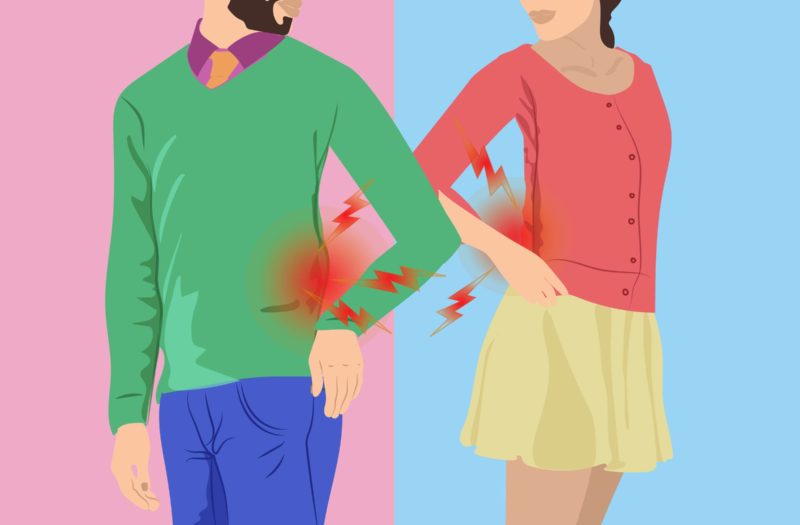Key Takeaways
- Men and women experience psoriatic arthritis differently
- Women tend to have more pain and fatigue from their disease than men
- Men had more skin involvement
A new study found that men and women experience psoriatic arthritis differently. The researchers believe this information can help clinicians target treatment better. For example, women might need more treatment for pain and fatigue, and men might benefit from treatment targeting back pain and skin.
Researchers completed a systematic literature review of works published between January 1, 2015, and November 13, 2020, via MEDLINE, Embase, and the Cochrane Database of Systematic Reviews. They looked for observational studies on psoriatic arthritis that reported results separately by gender. The scientists excluded studies with less than 100 participants and interventional studies.
They included 27 different studies with participants who were, on average, between ages 41.9 and 58.3. Most of the participants were women, and researchers collected data on:
- Patient characteristics
- Demographics
- Disease outcomes
- Study design
Despite diagnosis occurring in similar numbers for men and women, there were distinct differences in symptoms. Some of the researchers’ findings included:
- Women had higher rates of peripheral disease, indicating they had higher counts of tender joints
- Men had higher rates of axial disease, with higher rates of ankylosing spondylitis
- Men had higher rates of plaque psoriasis
- Women scored worse in pain, fatigue, functional limitations, and work disability
- Women had poorer responses to treatment
The researchers found that their study could not give more information about how much the disease affected the participants. To know more, they would need to talk with each person. Because this study looked at other studies, they could not get more information from the people involved.
The scientists noted that their results do not detail self-reported functional impairment, pain levels, and the overall effect of the disease; interviews with each participant would be necessary. Since this study looked at previously conducted observational studies, it was impossible to dig deeper into participants’ answers.
“I think gender differences are becoming a key interest in rheumatology, and it’s clear that there is increasing evidence of differential disease presentation, impact, and response,” says Laura Coates. MBChB, MRCP, PhD, an NIHR Clinical Scientist, and lead author. “This study brought a great deal of data together to look for patterns across multiple studies and found a lot of consistency.”
“I think the main thing is that we have to treat everyone as an individual, and how we interpret outcome measures and plan trials should probably start to take sex or gender into account more.”
Gender Bias in Health Care
Much of the literature shows that psoriatic arthritis can affect both men and women, but women are more likely to experience pain, fatigue, and functional limitations. They are also more likely have a longer duration of symptoms before diagnosis than men. This is because their symptoms are often dismissed by doctors.
Gender bias in health care, which is still a problem today, may play a role.
A 2018 study found that doctors view men with chronic pain as brave, while they describe women with chronic pain as emotional or hysterical. A survey of physicians and dentists, also completed in 2018, found that health care professionals believe women exaggerate their pain.
Gender bias in health care can have significant consequences. Women whose symptoms are dismissed may avoid doctors, missing important health care checkups. They may delay treatment until symptoms can no longer be ignored, which could be too late for effective treatment.
If you are experiencing symptoms of psoriatic arthritis, it’s important to see a doctor right away. Do not let gender bias prevent you from getting the care you need.
What This Means for You
Women with psoriatic arthritis are more likely to have fatigue and pain. But men are more likely to experience back pain and plaques on their skin. Both men and women can have trouble doing things they used to be able to do, and their symptoms can make it hard to work.
It’s important to get diagnosed and treated for psoriatic arthritis as soon as possible. A study published in 2021 found that if people wait even six months to get diagnosed, they might not respond as well to treatment.
“Unfortunately, it can take a while to get diagnosed,” says Amro Balki, MD, a rheumatologist. “But it might take longer for women, because they might get misdiagnosed before they see a rheumatologist.”
Once you’re diagnosed, it’s important to see your rheumatologist regularly so they can help you manage your condition.
Be a More Proactive Patient with ArthritisPower
ArthritisPower is a patient-led, patient-centered research registry for joint, bone, and inflammatory skin conditions. You can participate in voluntary research studies about your health conditions and use the app to track your symptoms, disease activity, and medications — and share with your doctor. Learn more and sign up here.
Coates, L., et al. “Sex-Specific Differences in Patients With Psoriatic Arthritis: A Systematic Review.” The Journal of Rheumatology. April 2023: doi: https://doi.org/10.3899/jrheum.220386.
Passia, E., et al. Sex-specific differences and how to handle them in early psoriatic arthritis. Arthritis Res Therapy. 2022. doi: https://doi.org/10.1186/s13075-021-02680-y.
Samulowitz, A, et al. “‘Brave Men’ and ‘Emotional Women’: A Theory-Guided Literature Review on Gender Bias in Health Care and Gendered Norms towards Patients with Chronic Pain.” Pain Research and Management. 2018. doi: https://doi.org/10.1155/2018/6358624.
Wesolowicz, D., et al. “The Roles of Gender and Profession on Gender Role Expectations of Pain in Health Care Professionals.” Journal of Pain Research. June 15, 2018). doi: https://doi.org/10.2147/JPR.S162123.






